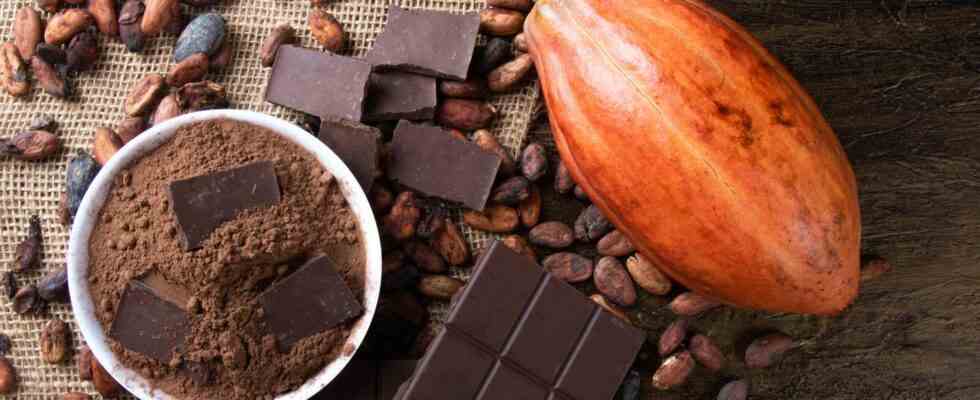Supply chains, wages and Co.
Fairtrade chocolate: what to look out for when buying
Modern day slavery still exists in the manufacture of chocolate. That is why it is so important to take a closer look when buying.
© gustavomellossa / iStock / Getty Images
Chocolate is not just chocolate: in addition to the wide range of varieties that are available on the market, the manufacturing conditions are also important to many. When you buy Fairtrade chocolate, you know the conditions are good. What else you should consider.
Chocolate is also one of the most popular sins in Germany. No wonder: it puts you in a good mood, tastes delicious in most cases and is also a wonderful gift. However, the happy treat also has a downside: its most important ingredient, cocoa, has a long history of exploitation. Not only that primeval and rain forests are cleared in favor of plantations. People, especially children, are paid starvation wages for hard labor in the fields. Fairtrade chocolate should prevent or at least curb this exploitation of people and nature and show consumers that they can buy and enjoy the chocolate with a clear conscience. What else you should consider when buying Fairtrade chocolate.
What is Fairtrade chocolate?
One of the most famous fair trade brands when it comes to chocolate is Tony’s Chocolonely. The brand was founded after journalist Teun “Tony” van de Keuken found out that buying chocolate in many cases supports modern slavery and illegal child labour. Impact Editor Belinda Borck says about the problems in the production of chocolate: “The value chain in cocoa is structured like an hourglass. On the one hand there are millions of small farmers who grow the cocoa, on the other hand billions of consumers: “In the middle. There are just a handful of big chocolate companies that process most of the cocoa beans. These big chocolate makers naturally want to make as much profit as possible, so it’s in their interest to buy the cocoa as cheaply as possible.”
The result: Prices are pushed down and at the end of the day, the cocoa farmers receive less than one euro for their work. This income is well below the extreme poverty line. “This in turn means that farmers have to use the cheapest labor on their plantations, which in turn leads to child labor and modern slavery.”
According to a 2020 report by the National Opinion Research Center (NORC), 1.56 million children work in illegal conditions. At least 30,000 people are victims of modern slavery, according to the report. Borck further explains: “The Fairtrade seal, as an external certification, means that the cocoa farmers are paid a higher price for their raw material, so that this problem is counteracted. The seal is therefore a first step towards the livelihood of the cocoa farmers: to improve internally. Even though we have been Fairtrade certified since day one, we recognize that farm and cooperative certification alone is not enough.”
Because even the additional certification premium does not guarantee the farmers a livelihood. According to the expert, more is needed for this. “For this reason, we have developed a model for calculating the price of cocoa (LIRP) based on state-of-the-art research, which enables farmers to achieve it.” In addition, there is a premium and a cooperative fee, which always allows the difference to the living income even with fluctuating world market prices. It is therefore best to find out exactly which chocolate you are going to use and what the philosophy behind it is. In addition to Tony’s Chocolonely, other brands are now very active against modern slavery, including for example jocolade (the chocolate from moderator Joko Winterscheidt and part of Tony’s Open Chain), Fair Africa, The Nu Company (in addition to fair trade, the topics of vegan enjoyment and climate change are also on the agenda) or also gepa and Rapunzelboth of whom also value organic products.
Why is it important to choose Fairtrade chocolate?
Since it is not always possible to obtain comprehensive information with every purchase in everyday life, certifications such as Fairtrade are an important step in the right direction for companies and often offer a good initial orientation for consumers, Borck believes. “By meeting certain minimum requirements through an external framework, companies embark on the path to incremental change.” Nevertheless, chocolate companies are responsible for their supply chains and their impact, not the certifiers. “In addition, it is the task of governments to pass laws that make every company responsible and thus make seals obsolete.”
What else should you consider when buying chocolate?
If you don’t just value taste, but want to deal with the injustices in the chocolate industry, you should find out more: “It’s important to question brands and seals and to see what’s behind them. And you should incorporate this knowledge into your purchasing decision Because only when consumers ask questions and demand really fairly traded chocolate is there enough pressure on the manufacturers to take responsibility,” says Belinda Borck. And in the end, chocolate can be enjoyed even more with a clear conscience.
Sources: Fairtrade.de / Fair Report by Tony’s Chocolonely / NORC Report 2020
You might also be interested in:
This article contains so-called affiliate links. There is more information here.

